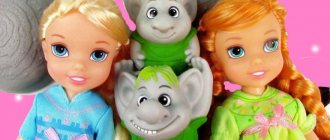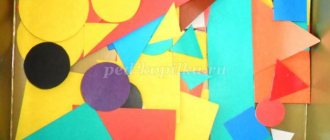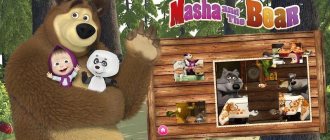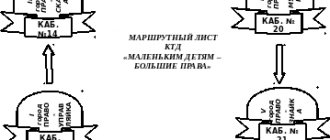Didactic games and exercises in mathematics for children 4 - 6 years old
Didactic games and exercises in mathematics for preschoolers
This brochure presents games that can be used at home to help a child develop mathematical abilities using gaming methods and techniques.
And also as a didactic manual for individual developmental and correctional classes, and for classes on the formation of elementary mathematical concepts in kindergarten. The concept of “formation of mathematical abilities” is quite complex and complex. It consists of interrelated and interdependent ideas about space, shape, size, time, quantity, which are necessary for the cognitive development of the child. We want to show you how you can help your child develop mathematical abilities at home using gaming methods and techniques. Children's games are excellent helpers in a child's development. The game is beneficial because it unobtrusively teaches new skills, develops children's thinking and imagination, and helps to establish control over behavior. In a playful form, it is easier and more effective to convey information, teach how to concentrate attention and solve problems. The process brings joy and pleasure to the child, he easily turns on and shows genuine interest, independently understands tasks and actively searches for answers, tries to cope with difficulties. Didactic games and play exercises also act as a means of comprehensive education of the child’s personality. What does comprehensive development of a child mean? If adults devote 10-15 minutes to their child, the child will speak correctly and think logically and will be your smartest and most developed child. The role of didactic games and game exercises in the formation of elementary mathematical concepts in preschoolers is very great. They help the child learn how the world around him works and broaden his horizons. The home environment contributes to the child’s liberation and he learns educational material at his own pace, consolidating the knowledge acquired in kindergarten. Parents, in turn, learn a lot about their child. Therefore, we can recommend some mathematical games and exercises for doing them with the family. These games are available for children starting from early preschool age, and do not require lengthy preparation or production of complex didactic material
“Match the wheels to the trailers”
Purpose of the game:
learning to distinguish and name geometric shapes, establishing correspondence between groups of shapes, counting to 5.
Progress of the game: the child is asked to select the appropriate wheels - red wheels for the blue trailer, and blue wheels for the red one.
Then you need to count the wheels from left to right for each carriage separately (cars and wheels can be cut out of colored cardboard in 5-10 minutes). "Days of the week"
Game exercise - What day of the week is the 1st (3rd, 5th) in a row?: -Today is Friday. What day will it be tomorrow? -Thursday – what day is it? — What day of the week will be after Tuesday? -What day is between Thursday and Tuesday? -How many days are there in a week?
“Name a similar item”
Game exercise
Purpose of the game:
development of visual attention, observation and coherent speech.
Progress of the game
: an adult asks the child to name objects that are similar to different geometric shapes, for example, “Find what looks like a square” or find all the round objects... This game can easily be played while traveling or on the way home.
“Find and name”
Goal
: consolidate the ability to quickly find a geometric figure of a certain size and color.
Procedure: 10-12 geometric shapes of different colors and sizes are laid out in chaos on the table in front of the child.
The presenter asks to show various geometric shapes, for example: a large circle, a small blue square, etc. Orientation in space
Game exercise Place any toys around the child on four sides (left, right, front, back). Questions: Who is standing to your right (left)? Who is standing in front (behind) of you? Where is the hare? (to my left) Where is the car? (behind me), etc.
"Collect the beads"
Game exercise
Purpose of the game:
to develop the perception of color, size;
ability to generalize and concentrate attention; speech. Progress of the game : for sequences, you can use a Lego constructor, figures cut out of paper (but I prefer figures made from kitchen cellulose napkins - they are more convenient to work with), and any other objects.
“Who knows, let him keep counting”
Game exercise For example, an adult calls the number 5 and says: “Count further” (and so on with any number up to 10). Name the numbers before 6 (5, 3, 4, etc.) Name the numbers after 3 (4, 7, 6, etc.) Name the number that is 1 more (or 1 less than the one named). Counting in a chain (one at a time). The adult starts - “one”, the child continues - “two”, the adult - “three”, the child - “four”, etc. up to 10. Then the child starts counting first.
“Orientation in space”
Game exercise Who is where? Place any toys around the child on four sides (left, right, front, back). Questions: Who is standing to your right (left)? Who is standing in front (behind) of you? Where is the hare? (to my left) Where is the car? (behind me), etc.
We recommend watching:
Didactic game for preschoolers for the development of fine motor skills Passport of the mathematics corner of the senior group Mathematical fairy tales for children 5-7 years old Summary of a lesson on FEMP in the preparatory group of a preschool educational institution. Forest adventures
Similar articles:
Math games for children 5 years old
Math games for a 6 year old child
Math tasks in pictures for children 6-7 years old
Exercises with counting sticks for preschoolers
Teaching mathematics using the Nikitin method
Methodology for conducting classes on FEMP in kindergarten
As a training base for those preparing to go to first grade, special methods are used:
- subsequence;
- consistency;
- individuality;
- logic.
The knowledge that the teacher imparts to children becomes more and more complex from lesson to lesson, taking into account the level of development of the students. For repetition, special role-playing games are used. Mathematics becomes the pupils’ favorite subject; they study with pleasure, look for similarities and differences in subjects, and focus on subtleties in order to answer the teacher’s question.
Game with the teacher
Recommendations for organizing classes
It is important to organize the game positively and competently. Kindergarten age does not provide for the use of unsatisfactory grades or reprimands from the teacher. You cannot compare one child with another; only an analysis of the student’s personal growth is allowed.
The teacher must use in his work those methods and techniques that provoke interest. “Forced” classes are useless and create aversion to mathematics and algebra.
For your information. If there is personal contact and a positive relationship between the student and his mentor, there will be a successful outcome.
An example of a calendar-thematic lesson plan for FEMP
In the morning, the teacher talks about the heroes of the fairy tale “Turnip”. Together, participants look at pictures of characters. Next, during the walk, the participants play the game “Line up like a turnip in a fairy tale,” and at lunchtime the teacher tells the fairy tale “Turnip.” In the evening, the fairy tale is played out, and unconventional drawing of geometric shapes takes place. During the second walk, the children and the teacher play “Edible-Inedible” (with a ball) and put together the “Turnip” puzzle. They create costumes for the fairy tale “Turnip”.
The Federal State Educational Standard for kindergartens contains a list of concepts that should be developed by graduates of preschool educational institutions.
The role of didactic games in FEMP classes in kindergarten
The age of 5-6 years is the most important time in a child’s life. At this time, fantasy and logic are formed, the arbitrariness of mental processes and self-esteem are formed. Children always want to know - why, how, why?
Lesson with numbers
At the preschool educational institution, the preparatory process for an educational institution begins, and cognitive activity develops. This is precisely the goal pursued by FEMP pedagogy. Children must not only be able to count to 10 back and forth, but also analyze information data, conduct analysis, classify different phenomena, find common patterns, be smart, and be able to explain and prove a personal point of view.
Age groups in kindergarten by year according to Federal State Educational Standards
Types of Math Activities for Kindergarteners
Didactic mathematical games are divided into certain groups according to their content. Type of DI:
- with figures and numbers;
- time travel;
- orientation in space;
- with geometric shapes;
- to logic.
Thanks to different types of games, students are taught to count forward and backward, and to use actions according to the rules of numerals, both quantitative and ordinal.






